图像特征提取算法
LBP算法(人脸识别特征提取)

LBP算法(人脸识别特征提取)LBP(Local Binary Patterns)算法是一种用于人脸识别中的特征提取算法。
该算法能够有效地描述图像局部纹理特征,通过将图像划分为不同的区域,并计算每个区域的局部二值模式(Local Binary Pattern),从而提取出图像的纹理特征。
本文将介绍LBP算法的原理、应用以及算法的优缺点。
LBP算法的原理是基于图像局部纹理的分布统计。
算法首先将图像划分为若干个重叠的圆形区域,然后选取每个区域的中心像素点作为参考点,根据参考点和周围像素的灰度值大小关系,将周围像素的灰度值二值化。
具体而言,如果周围像素的灰度值大于或等于参考点的灰度值,则将其对应位置的二值设置为1,否则设置为0。
这样,就得到了一个局部二值模式。
对于每个局部二值模式,在其周围像素形成的二进制数中,可以计算出一个十进制的值,该值即为对应的LBP值。
然后,可以统计整个图像中不同LBP值的出现次数,以得到该图像的纹理特征向量。
为了保持LBP特征的旋转不变性,通常将计算得到的纹理特征向量进行旋转不变模式(Rotation-Invariant Patterns)的处理。
LBP算法在人脸识别中的应用非常广泛。
通过提取图像的纹理特征,LBP算法能够有效地区分人脸图像中不同的区域,从而实现人脸检测、人脸识别等任务。
与其他特征提取算法相比,LBP算法具有计算简单、计算效率高以及对光照变化、表情变化等具有较强的鲁棒性的优点。
然而,LBP算法也存在一些缺点。
首先,LBP算法提取的特征主要反映了图像的纹理信息,对于人脸的形状、结构等特征没有很好的表达能力。
其次,LBP算法对于像素点近邻选择的问题较为敏感,不同的近邻选择可能会导致特征的差异。
最后,LBP算法没有考虑像素点的空间关系,在一些图像中可能导致特征提取不准确。
为了克服这些缺点,研究人员对LBP算法进行了改进和扩展,提出了许多改进的LBP算法。
例如,Extended LBP(ELBP)算法结合了LBP算法和傅里叶描述子,融合了纹理和形状信息;Uniform LBP(ULBP)算法通过将LBP值分为不同的均匀模式,增强了特征的区分能力和鲁棒性;Multi-scale LBP(MLBP)算法在不同尺度下提取LBP特征,增强了特征的描述能力。
面向无人机航拍的图像处理与特征提取算法

面向无人机航拍的图像处理与特征提取算法无人机航拍技术的快速发展使得无人机在各个领域的应用越来越广泛,其中之一便是航拍图像的获取与处理。
面向无人机航拍的图像处理与特征提取算法是无人机航拍技术中至关重要的一环,它可以帮助我们从无人机航拍图像中获取有用的信息,并为后续的分析与决策提供支持。
在本文中,我们将探讨面向无人机航拍的图像处理与特征提取算法的相关技术与应用。
1. 图像处理算法无人机航拍图像的质量受限于飞行高度、天气条件等因素,因此需要进行图像处理以提高图像质量和清晰度。
在面向无人机航拍的图像处理算法中,包括图像增强、图像去雾、图像去噪等技术。
图像增强技术可以通过调整图像的亮度、对比度、色彩等参数,使图像更加鲜明、清晰。
在无人机航拍中,可能会受到光线不均匀、阴影、反射等问题的影响,因此需要针对不同场景采用不同的图像增强算法。
图像去雾技术可以去除图像中的雾霭效应,提高图像的可视性和细节清晰度。
无人机在高空进行航拍时,可能会受到大气中的雾、烟尘等因素的干扰,导致图像变得模糊不清。
因此,图像去雾算法的研究对于无人机航拍图像的质量提升至关重要。
图像去噪技术可以消除图像中的噪声干扰,提高图像的信噪比和清晰度。
无人机航拍图像可能会受到运动模糊、传感器噪声等因素的影响,导致图像中出现噪点、细节模糊等问题。
图像去噪算法可以在保持图像细节的前提下,去除图像中的噪声,提高图像的质量。
2. 特征提取算法特征提取是无人机航拍图像处理的关键任务之一。
通过提取图像中的特征信息,可以实现目标检测、目标跟踪、地物分类等应用。
在面向无人机航拍的特征提取算法中,包括边缘检测、角点检测、纹理特征提取等技术。
边缘检测算法可以从图像中提取出物体的边界信息,帮助我们识别和定位目标。
无人机航拍图像中可能存在复杂的背景干扰和目标重叠的情况,因此需要采用高效的边缘检测算法,来寻找目标的边界信息。
角点检测算法可以提取图像中的角点特征,通常用于图像匹配和目标跟踪。
基于深度学习的图像特征提取算法研究
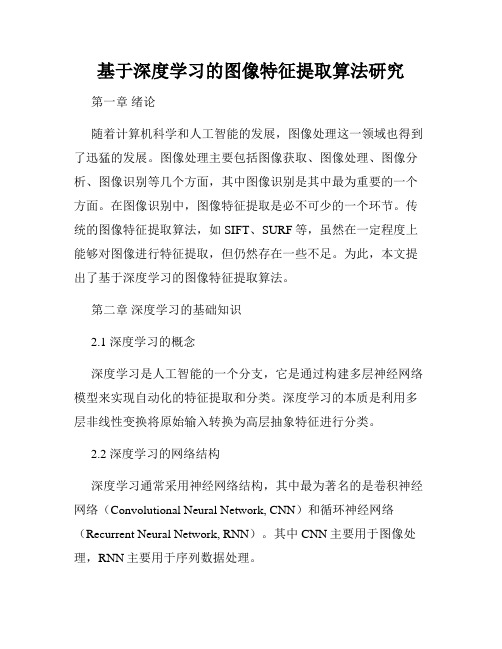
基于深度学习的图像特征提取算法研究第一章绪论随着计算机科学和人工智能的发展,图像处理这一领域也得到了迅猛的发展。
图像处理主要包括图像获取、图像处理、图像分析、图像识别等几个方面,其中图像识别是其中最为重要的一个方面。
在图像识别中,图像特征提取是必不可少的一个环节。
传统的图像特征提取算法,如SIFT、SURF等,虽然在一定程度上能够对图像进行特征提取,但仍然存在一些不足。
为此,本文提出了基于深度学习的图像特征提取算法。
第二章深度学习的基础知识2.1 深度学习的概念深度学习是人工智能的一个分支,它是通过构建多层神经网络模型来实现自动化的特征提取和分类。
深度学习的本质是利用多层非线性变换将原始输入转换为高层抽象特征进行分类。
2.2 深度学习的网络结构深度学习通常采用神经网络结构,其中最为著名的是卷积神经网络(Convolutional Neural Network, CNN)和循环神经网络(Recurrent Neural Network, RNN)。
其中CNN主要用于图像处理,RNN主要用于序列数据处理。
2.3 深度学习的常见算法深度学习的常见算法包括深度前馈网络(Deep Feedforward Network, DFN)、CNN、RNN、自编码器(Autoencoder)、生成对抗网络(Generative Adversarial Network, GAN)等。
第三章基于深度学习的图像特征提取算法3.1 图像预处理在深度学习中,图像预处理是非常重要的一步,它可以有效提高特征的稳定性和鲁棒性。
常见的图像预处理包括图像归一化、颜色空间转换、图像增强等。
3.2 特征提取在基于深度学习的图像特征提取算法中,特征提取通常采用卷积神经网络。
卷积神经网络通常包括多层卷积层、池化层和全连接层。
其中卷积层和池化层能够对图像进行特征提取和降维,全连接层则可以对降维后的特征进行分类。
3.3 特征表示图像特征提取后,需要对特征进行表示。
图像处理中的形状特征提取算法研究
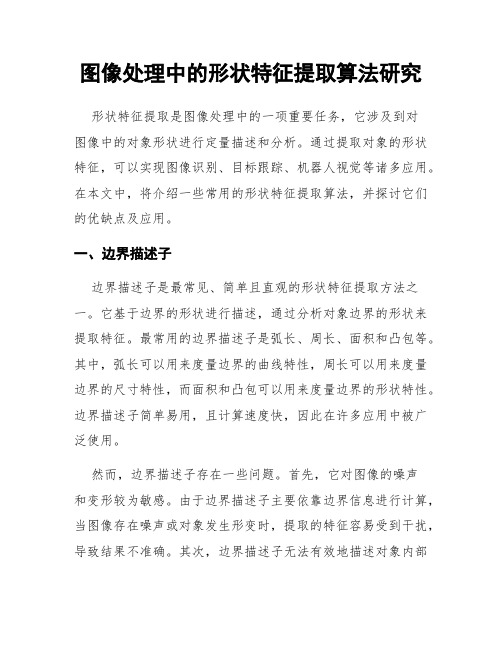
图像处理中的形状特征提取算法研究形状特征提取是图像处理中的一项重要任务,它涉及到对图像中的对象形状进行定量描述和分析。
通过提取对象的形状特征,可以实现图像识别、目标跟踪、机器人视觉等诸多应用。
在本文中,将介绍一些常用的形状特征提取算法,并探讨它们的优缺点及应用。
一、边界描述子边界描述子是最常见、简单且直观的形状特征提取方法之一。
它基于边界的形状进行描述,通过分析对象边界的形状来提取特征。
最常用的边界描述子是弧长、周长、面积和凸包等。
其中,弧长可以用来度量边界的曲线特性,周长可以用来度量边界的尺寸特性,而面积和凸包可以用来度量边界的形状特性。
边界描述子简单易用,且计算速度快,因此在许多应用中被广泛使用。
然而,边界描述子存在一些问题。
首先,它对图像的噪声和变形较为敏感。
由于边界描述子主要依靠边界信息进行计算,当图像存在噪声或对象发生形变时,提取的特征容易受到干扰,导致结果不准确。
其次,边界描述子无法有效地描述对象内部的形状信息。
由于边界描述子只关注对象的边界,无法考虑对象的内部结构,因此在处理复杂形状的对象时效果有限。
二、轮廓描述子轮廓描述子是一种基于轮廓的形状特征提取方法,它通过将对象的轮廓进行数学描述来提取特征。
常用的轮廓描述子有Hu矩、Zernike矩和傅里叶描述子等。
其中,Hu矩是最常用的一种轮廓描述子,它可以通过一系列归一化的矩来描述对象的形状特征。
而Zernike矩和傅里叶描述子则通过将对象的轮廓分解为一系列基函数的系数来表示。
轮廓描述子相比边界描述子具有以下优点。
首先,它对图像的噪声和变形具有较好的鲁棒性。
轮廓描述子可以通过综合考虑轮廓的形状和结构信息,来减少噪声和形变的干扰,提取更准确的特征。
其次,轮廓描述子具有较好的旋转和尺度不变性。
由于轮廓描述子是基于轮廓形状的数学描述,因此对于对象的旋转和尺度变化具有一定的鲁棒性。
然而,轮廓描述子也存在一些问题。
首先,它对对象的光照变化和纹理变化较为敏感。
图像处理中的特征提取与分类算法
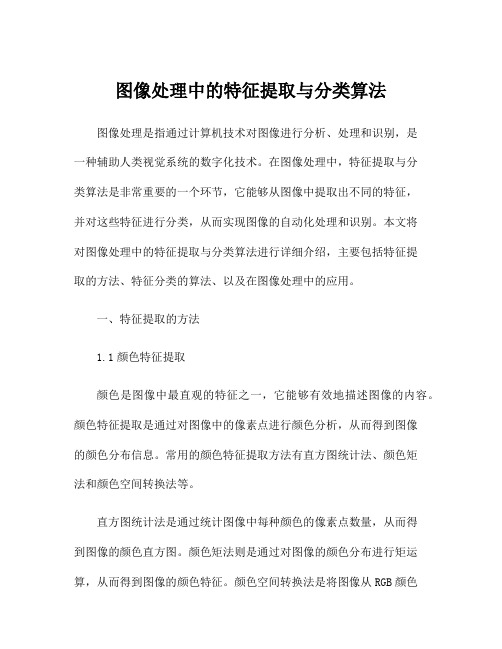
图像处理中的特征提取与分类算法图像处理是指通过计算机技术对图像进行分析、处理和识别,是一种辅助人类视觉系统的数字化技术。
在图像处理中,特征提取与分类算法是非常重要的一个环节,它能够从图像中提取出不同的特征,并对这些特征进行分类,从而实现图像的自动化处理和识别。
本文将对图像处理中的特征提取与分类算法进行详细介绍,主要包括特征提取的方法、特征分类的算法、以及在图像处理中的应用。
一、特征提取的方法1.1颜色特征提取颜色是图像中最直观的特征之一,它能够有效地描述图像的内容。
颜色特征提取是通过对图像中的像素点进行颜色分析,从而得到图像的颜色分布信息。
常用的颜色特征提取方法有直方图统计法、颜色矩法和颜色空间转换法等。
直方图统计法是通过统计图像中每种颜色的像素点数量,从而得到图像的颜色直方图。
颜色矩法则是通过对图像的颜色分布进行矩运算,从而得到图像的颜色特征。
颜色空间转换法是将图像从RGB颜色空间转换到其他颜色空间,比如HSV颜色空间,从而得到图像的颜色特征。
1.2纹理特征提取纹理是图像中的一种重要特征,它能够描述图像中不同区域的物体表面特性。
纹理特征提取是通过对图像中的像素点进行纹理分析,从而得到图像的纹理信息。
常用的纹理特征提取方法有灰度共生矩阵法、小波变换法和局部二值模式法等。
灰度共生矩阵法是通过统计图像中不同像素点的灰度级别分布,从而得到图像的灰度共生矩阵,进而得到图像的纹理特征。
小波变换法是通过对图像进行小波变换,从而得到图像的频域信息,进而得到图像的纹理特征。
局部二值模式法是采用局部像素间差异信息作为纹理特征,从而得到图像的纹理特征。
1.3形状特征提取形状是图像中的一种重要特征,它能够描述图像中物体的外形和结构。
形状特征提取是通过对图像中的像素点进行形状分析,从而得到图像的形状信息。
常用的形状特征提取方法有轮廓分析法、边缘检测法和骨架提取法等。
轮廓分析法是通过对图像中物体的外轮廓进行分析,从而得到图像的形状特征。
图像特征及图像特征提取

图像特征及图像特征提取图像特征是图像中的显著和重要的信息,用于描述和区分不同的图像。
图像特征提取是从图像中提取这些特征的过程。
图像特征可以分为两类:全局特征和局部特征。
全局特征是整个图像的统计性质,例如颜色直方图、颜色矩和纹理特征等。
局部特征则是在图像的局部区域中提取的特征,例如SIFT(尺度不变特征变换)、HOG(方向梯度直方图)和SURF(加速稳健特征)等。
图像特征提取的过程可以分为以下几步:1.预处理:对图像进行去噪、图像增强、颜色空间转换等处理,以提高图像的质量和可分辨性。
2.特征选择:根据具体应用需求和图像特征的表达能力,选择适合的特征。
例如,对于目标识别任务,可以选择具有良好局部不变性和可区分性的局部特征。
3.特征提取:根据选择的特征,从图像中提取特征。
对于全局特征,可以使用颜色直方图、颜色矩、纹理特征等方法;对于局部特征,可以使用SIFT、HOG、SURF等方法。
4.特征表示:将提取的特征表示为向量或矩阵形式,以便后续的分类、检索或识别任务。
5.特征匹配:对于图像检索、图像匹配等任务,需要将查询图像的特征与数据库中的图像特征进行比较和匹配,找到最相似的图像。
图像特征提取的方法和算法有很多,以下是一些常用的方法:1.颜色特征:颜色是图像的重要特征之一、颜色直方图描述了图像中每个颜色的分布情况,颜色矩描述了图像中颜色的平均值和方差等统计性质。
2.纹理特征:纹理是图像中的重要结构信息。
常用的纹理特征提取方法有灰度共生矩阵、方向梯度直方图、小波变换等。
3.形状特征:形状是物体的基本属性之一、形状特征提取方法有边缘检测、形状描述子等。
4.尺度不变特征变换(SIFT):SIFT是一种局部特征提取方法,具有尺度不变性和旋转不变性,适用于图像匹配和目标识别任务。
5.方向梯度直方图(HOG):HOG是一种局部特征提取方法,通过计算图像中每个像素的梯度方向和强度,获得图像的局部特征。
6.加速稳健特征(SURF):SURF是一种局部特征提取方法,具有尺度不变性和旋转不变性,适用于图像匹配和目标识别任务。
hog特征提取算法 matlab
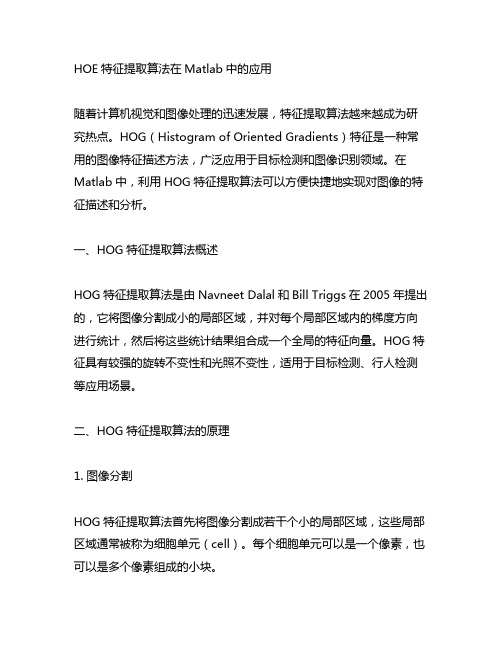
HOE特征提取算法在Matlab中的应用随着计算机视觉和图像处理的迅速发展,特征提取算法越来越成为研究热点。
HOG(Histogram of Oriented Gradients)特征是一种常用的图像特征描述方法,广泛应用于目标检测和图像识别领域。
在Matlab中,利用HOG特征提取算法可以方便快捷地实现对图像的特征描述和分析。
一、HOG特征提取算法概述HOG特征提取算法是由Navneet Dalal和Bill Triggs在2005年提出的,它将图像分割成小的局部区域,并对每个局部区域内的梯度方向进行统计,然后将这些统计结果组合成一个全局的特征向量。
HOG特征具有较强的旋转不变性和光照不变性,适用于目标检测、行人检测等应用场景。
二、HOG特征提取算法的原理1. 图像分割HOG特征提取算法首先将图像分割成若干个小的局部区域,这些局部区域通常被称为细胞单元(cell)。
每个细胞单元可以是一个像素,也可以是多个像素组成的小块。
2. 梯度方向统计对每个细胞单元内的像素进行梯度计算,得到梯度的方向和大小。
通常可以利用Sobel算子或Prewitt算子等来计算梯度。
然后将梯度方向的统计结果组合成一个直方图,并将相邻的若干个细胞单元的直方图进行归一化。
3. 特征向量的计算将所有细胞单元的直方图组合成一个全局的特征向量。
这个特征向量可以用来表示图像的特征。
三、在Matlab中实现HOG特征提取算法在Matlab中,可以利用自带的图像处理工具箱或者第三方的工具箱来实现HOG特征提取算法。
以下是一个简单的实现示例:```matlab读取图像img = imread('example.jpg');计算梯度[gx, gy] = imgradientxy(img, 'sobel');计算梯度的方向和大小[grad, dir] = imgradient(gx, gy);定义细胞单元大小和细胞单元的数量cellSize = 8;numBins = 9;计算HOG特征[hog, vis] = extractHOGFeatures(img, 'CellSize', [cellSize cellSize], 'BlockSize', [2 2], 'NumBins', numBins);可视化HOG特征figure;imshow(img); hold on;plot(vis);```在这个示例中,我们首先读取了一张名为'example.jpg'的图像,然后使用'imgradientxy'函数计算了图像的梯度,接着利用'imgradient'函数计算了梯度的方向和大小。
图像处理中的图像特征提取算法综述

图像处理中的图像特征提取算法综述图像处理是计算机视觉领域的一个重要研究方向,而图像特征提取算法则是图像处理的核心之一。
图像特征提取是从图像中提取出有用信息的过程,可以用于图像分类、目标检测、图像检索等各种任务。
本文将综述图像处理中的图像特征提取算法,并对各种算法的优缺点进行评述。
一、传统图像特征提取算法1. 颜色特征提取算法颜色是图像中最直观的特征之一,许多图像处理任务中都需要考虑颜色特征。
常见的颜色特征提取算法有色彩直方图、颜色矩和颜色熵等。
色彩直方图统计图像中每种颜色的像素个数,可以用于颜色分布的分析;颜色矩则通过计算像素值的均值和方差来描述颜色的分布特征;颜色熵用于衡量图像中颜色的复杂程度,可以区分不同图像的颜色分布情况。
2. 纹理特征提取算法纹理是图像中的重要特征,可以用于图像分类、图像检索等任务。
传统的纹理特征提取算法主要有灰度共生矩阵(Gabor 滤波器和局部二值模式(LBP)等。
灰度共生矩阵基于像素灰度值的概率分布来计算纹理特征,常用的特征包括对比度、能量、熵和相关性等;Gabor滤波器是一种基于频率和方向特征的纹理特征提取方法,可以提取出图像中的边缘和纹理信息;LBP是一种用于描述图像局部纹理的方法,可以通过比较像素值大小来得到二值编码表示。
3. 形状特征提取算法形状是图像中的高级特征,可以表示物体的几何结构。
常见的形状特征提取算法有边缘检测、轮廓匹配和形状上下文等。
边缘检测算法通常利用图像的梯度信息来提取物体的边缘,包括Sobel算子、Canny边缘检测算法等;轮廓匹配算法是通过对比图像边缘的形状特征来进行物体匹配,可以用于目标检测和物体识别;形状上下文是一种基于统计的形状特征提取方法,通过计算物体边缘点之间的关系来描述物体的形状。
二、深度学习在图像特征提取中的应用传统的图像特征提取算法需要手动设计特征提取算子,存在人为主观因素,且很难处理复杂的图像语义信息。
而深度学习通过神经网络自动学习图像的特征表示,正在逐渐改变图像特征提取的方式。
基于视觉信息的图像特征提取算法研究共3篇
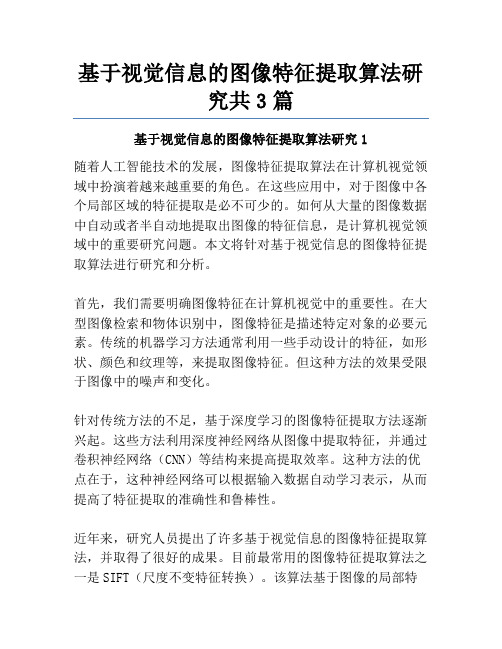
2006—2007学年第二学期期中试卷初三政治注意事项1、本试卷分第Ⅰ卷(选择题)和第Ⅱ卷(非选择题)两部分,共8页,考试时间100分钟,满分100分。
2、第Ⅰ卷答案一律答在第Ⅱ卷前面的答题卡上,答题时注意答题卡上的题号与试卷上的题号相一致,第Ⅱ卷答题答在各试题下面的空白处。
3、答题前请将第Ⅱ卷密封线内的学校、姓名、准考证号填写清楚。
第Ⅰ卷选择题一、单项选择题(以下各题都有四个答案,但正确答案均只有一个,请将正确答案的字母编号填入答题卡表格中相应空格内。
每题2分,共50分)1、每一个人在社会中都扮演着不同的角色,每一种角色都意味着一种责任。
下列说法不正确的是()A、作为子女,应承担体贴孝敬父母的责任B、作为朋友,应做到理解宽容、真诚相待C、爱岗敬业、热情奉献是对乘客的基本要求D、完成规定的学习任务是学生的主要义务2、做一个负责任的公民,就要()①信守承诺②勇担过错③自觉承担责任④做责任的主人A、①②③④B、①②③C、①④D、②③④3、积极参加社会公益活动的目的是能够让我们()①自觉承担起对他人,社会的责任②自身价值在奉献中得以提升③提高实践能力,增加社会经验④践行志愿者精神,传播先进文化A、①②③④B、①②③C、①②④D、②③④4、对于我们中学生来说,自觉承担责任就是()①自己的事自己做②做好力所能及的事③对自己做的事负责④做自己喜欢做的事A、①B、②③C、①②③D、①②③④5、下列有关社会主义初级阶段的认识,正确的有()①初级阶段就是不发达阶段②初级阶段从20世纪50年代中期算起,至少需要100的时间③初级阶段表现在经济、政治、文化生活的各方面④我国正处于社会主义初级阶段是我国最基本的国情A、①②③B、①②④C、①③④D、①②③④6、在社会主义现代化建设的进程中,制定一切路线、方针和政策的依据是()A、党在社会主义初级阶段的基本路线B、我国现阶段的基本国情C、“三个有利于”D、“三个代表”7、下列属于我国基本国策的是()①对外开放②计划生育③依法治国④保护环境A、①②③④B、②③④C、①②③D、①②④8、下列提法和做法不符合贯彻落实可持续发展战略要求的是()①但留方寸地,留与子孙耕②变湖泊为粮仓③反对使用一次性筷子④垃圾分类处理⑤禁止开发不可再生资源A、①②③④⑤B、②③④C、①③④D、②⑤9、下列关于中华文化和民族精神的关系,说法正确的是()①中华文化的力量,集中表现为民族精神的力量,所以说中华文化就是民族精神②中华民族精神,根植于绵延数千年的优秀文化传统之中,始终是维系中华各族人民共同生活的精神纽带③民族文化是根,民族精神是魂④民族文化和民族精神都具有时代性A、①②③B、②③④C、①②④D、①③④10、下列能够直接体现爱国主义精神的语句是()①苟利国家生死以,岂因祸福避趋之②天下兴亡,匹夫有责③人生自古谁无死,留取丹心照汗青④闲居非吾志,甘心赴国忧A、①②③B、①③④C、①②③④D、①②④11、宪法是国家的根本大法,它规定了国家生活中最根本、最主要的问题。
图像特征提取方法
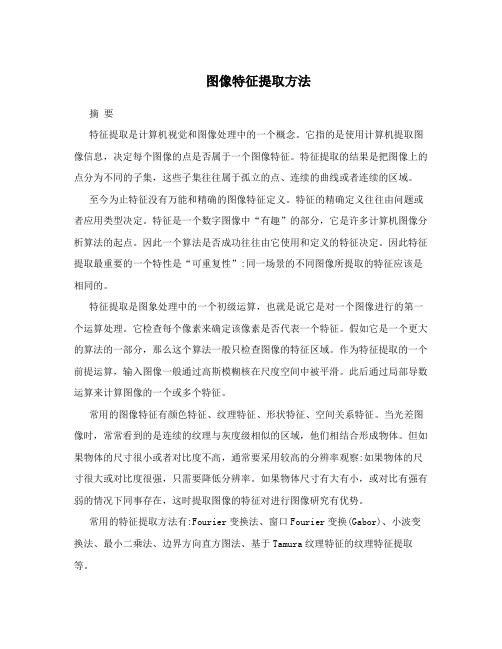
图像特征提取方法摘要特征提取是计算机视觉和图像处理中的一个概念。
它指的是使用计算机提取图像信息,决定每个图像的点是否属于一个图像特征。
特征提取的结果是把图像上的点分为不同的子集,这些子集往往属于孤立的点、连续的曲线或者连续的区域。
至今为止特征没有万能和精确的图像特征定义。
特征的精确定义往往由问题或者应用类型决定。
特征是一个数字图像中“有趣”的部分,它是许多计算机图像分析算法的起点。
因此一个算法是否成功往往由它使用和定义的特征决定。
因此特征提取最重要的一个特性是“可重复性”:同一场景的不同图像所提取的特征应该是相同的。
特征提取是图象处理中的一个初级运算,也就是说它是对一个图像进行的第一个运算处理。
它检查每个像素来确定该像素是否代表一个特征。
假如它是一个更大的算法的一部分,那么这个算法一般只检查图像的特征区域。
作为特征提取的一个前提运算,输入图像一般通过高斯模糊核在尺度空间中被平滑。
此后通过局部导数运算来计算图像的一个或多个特征。
常用的图像特征有颜色特征、纹理特征、形状特征、空间关系特征。
当光差图像时,常常看到的是连续的纹理与灰度级相似的区域,他们相结合形成物体。
但如果物体的尺寸很小或者对比度不高,通常要采用较高的分辨率观察:如果物体的尺寸很大或对比度很强,只需要降低分辨率。
如果物体尺寸有大有小,或对比有强有弱的情况下同事存在,这时提取图像的特征对进行图像研究有优势。
常用的特征提取方法有:Fourier变换法、窗口Fourier变换(Gabor)、小波变换法、最小二乘法、边界方向直方图法、基于Tamura纹理特征的纹理特征提取等。
设计内容课程设计的内容与要求(包括原始数据、技术参数、条件、设计要求等): 一、课程设计的内容本设计采用边界方向直方图法、基于PCA的图像数据特征提取、基于Tamura纹理特征的纹理特征提取、颜色直方图提取颜色特征等等四种方法设计。
(1)边界方向直方图法由于单一特征不足以准确地描述图像特征,提出了一种结合颜色特征和边界方向特征的图像检索方法.针对传统颜色直方图中图像对所有像素具有相同重要性的问题进行了改进,提出了像素加权的改进颜色直方图方法;然后采用非分割图像的边界方向直方图方法提取图像的形状特征,该方法相对分割方法具有简单、有效等特点,并对图像的缩放、旋转以及视角具有不变性.为进一步提高图像检索的质量引入相关反馈机制,动态调整两幅图像相似度中颜色特征和方向特征的权值系数,并给出了相应的权值调整算法.实验结果表明,上述方法明显地优于其它方法.小波理论和几个其他课题相关。
图像特征提取三大法宝
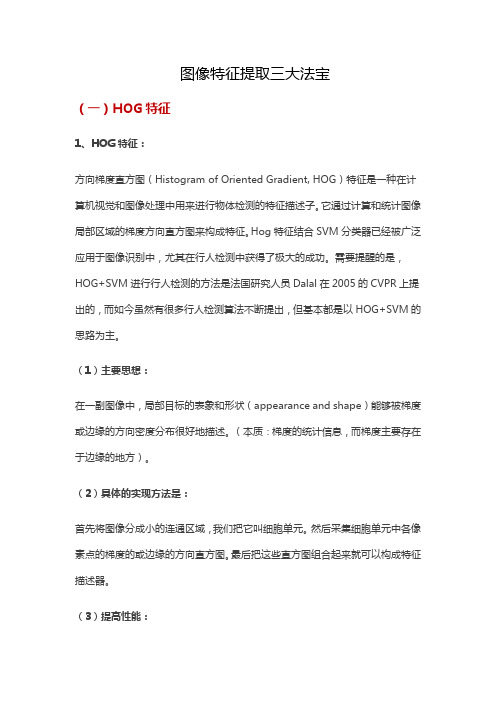
图像特征提取三大法宝(一)HOG特征1、HOG特征:方向梯度直方图(Histogram of Oriented Gradient, HOG)特征是一种在计算机视觉和图像处理中用来进行物体检测的特征描述子。
它通过计算和统计图像局部区域的梯度方向直方图来构成特征。
Hog特征结合SVM分类器已经被广泛应用于图像识别中,尤其在行人检测中获得了极大的成功。
需要提醒的是,HOG+SVM进行行人检测的方法是法国研究人员Dalal在2005的CVPR上提出的,而如今虽然有很多行人检测算法不断提出,但基本都是以HOG+SVM的思路为主。
(1)主要思想:在一副图像中,局部目标的表象和形状(appearance and shape)能够被梯度或边缘的方向密度分布很好地描述。
(本质:梯度的统计信息,而梯度主要存在于边缘的地方)。
(2)具体的实现方法是:首先将图像分成小的连通区域,我们把它叫细胞单元。
然后采集细胞单元中各像素点的梯度的或边缘的方向直方图。
最后把这些直方图组合起来就可以构成特征描述器。
(3)提高性能:把这些局部直方图在图像的更大的范围内(我们把它叫区间或block)进行对比度归一化(contrast-normalized),所采用的方法是:先计算各直方图在这个区间(block)中的密度,然后根据这个密度对区间中的各个细胞单元做归一化。
通过这个归一化后,能对光照变化和阴影获得更好的效果。
(4)优点:与其他的特征描述方法相比,HOG有很多优点。
首先,由于HOG是在图像的局部方格单元上操作,所以它对图像几何的和光学的形变都能保持很好的不变性,这两种形变只会出现在更大的空间领域上。
其次,在粗的空域抽样、精细的方向抽样以及较强的局部光学归一化等条件下,只要行人大体上能够保持直立的姿势,可以容许行人有一些细微的肢体动作,这些细微的动作可以被忽略而不影响检测效果。
因此HOG特征是特别适合于做图像中的人体检测的。
2、HOG特征提取算法的实现过程:大概过程:HOG特征提取方法就是将一个image(你要检测的目标或者扫描窗口):1)灰度化(将图像看做一个x,y,z(灰度)的三维图像);2)采用Gamma校正法对输入图像进行颜色空间的标准化(归一化);目的是调节图像的对比度,降低图像局部的阴影和光照变化所造成的影响,同时可以抑制噪音的干扰;3)计算图像每个像素的梯度(包括大小和方向);主要是为了捕获轮廓信息,同时进一步弱化光照的干扰。
SIFT特征提取算法
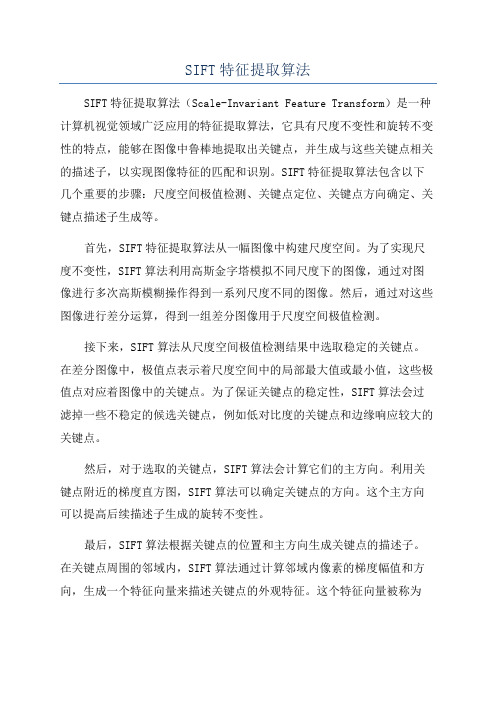
SIFT特征提取算法SIFT特征提取算法(Scale-Invariant Feature Transform)是一种计算机视觉领域广泛应用的特征提取算法,它具有尺度不变性和旋转不变性的特点,能够在图像中鲁棒地提取出关键点,并生成与这些关键点相关的描述子,以实现图像特征的匹配和识别。
SIFT特征提取算法包含以下几个重要的步骤:尺度空间极值检测、关键点定位、关键点方向确定、关键点描述子生成等。
首先,SIFT特征提取算法从一幅图像中构建尺度空间。
为了实现尺度不变性,SIFT算法利用高斯金字塔模拟不同尺度下的图像,通过对图像进行多次高斯模糊操作得到一系列尺度不同的图像。
然后,通过对这些图像进行差分运算,得到一组差分图像用于尺度空间极值检测。
接下来,SIFT算法从尺度空间极值检测结果中选取稳定的关键点。
在差分图像中,极值点表示着尺度空间中的局部最大值或最小值,这些极值点对应着图像中的关键点。
为了保证关键点的稳定性,SIFT算法会过滤掉一些不稳定的候选关键点,例如低对比度的关键点和边缘响应较大的关键点。
然后,对于选取的关键点,SIFT算法会计算它们的主方向。
利用关键点附近的梯度直方图,SIFT算法可以确定关键点的方向。
这个主方向可以提高后续描述子生成的旋转不变性。
最后,SIFT算法根据关键点的位置和主方向生成关键点的描述子。
在关键点周围的邻域内,SIFT算法通过计算邻域内像素的梯度幅值和方向,生成一个特征向量来描述关键点的外观特征。
这个特征向量被称为SIFT特征描述子,通常是一个128维的向量。
为了保证描述子的不变性,SIFT算法对特征向量进行了归一化和方向旋转等处理。
总结来说,SIFT特征提取算法通过尺度空间极值检测、关键点定位、关键点方向确定和关键点描述子生成等步骤,能够从图像中提取出具有尺度不变性和旋转不变性的关键点和描述子。
SIFT特征提取算法在计算机视觉领域有着广泛的应用,例如图像匹配、物体识别和三维重建等任务中都能够发挥重要作用。
数字图像处理中的特征提取及其应用

数字图像处理中的特征提取及其应用数字图像处理是一门关注如何使用计算机科学、数学等学科知识在数字图像中提取有用信息的学科。
在数字图像处理过程中,特征提取是至关重要的一步,它有利于我们从众多的图像数据中较为准确地提取出需要的信息。
在数字图像处理中的特征提取方法有很多种,本文将介绍几种常见的特征提取方法及其应用。
一、边缘检测边缘提取是图像处理中最重要的一个子问题,其中最流行的算法是Canny边缘检测算法。
它是一种基于图像梯度的算法。
边缘反映的是图像灰度的变化,所以,它是图像信息中最丰富的一部分。
Canny算法的基本思想是,通过预处理、梯度计算、非极大值抑制、双阈值分割等步骤,找到图像中所有的边缘。
Canny算法的应用场景非常广泛,例如在拍摄纹理繁杂的地方上,借助边缘检测的结果,我们可以更清晰地认识到物体的表面纹理,帮助我们理解和感受环境中的事物。
二、特征点检测在许多计算机视觉领域中,通常通过进行特征点提取和描述,来描述场景或分类对象。
特征点检测是计算机视觉领域的一项核心问题。
它的目的是找到图像中的关键点,称为特征点。
特征点通常会在图像比较重要、比较容易被检测到的位置出现,这些点是在计算机自动识别物体时非常重要的参考点。
特征点检测有很多种方法,其中最为常见的是SIFT,SURF和ORB。
SIFT算法采用高斯差分金字塔计算图像的特征点,SURF 算法采用速度快的旋转不变的特征,而ORB算法则是基于FAST 特征的二进制算法。
特征点检测的应用非常广泛,例如在拍摄移动物体时,我们可以通过对特定的移动轨迹跟踪,来确定目标的位置和动作。
在物体识别领域,我们可以利用特征点检测来实现物体识别。
三、纹理分析纹理是图像中的一种重要的视觉特征,而纹理分析通常用于分析图像数据集中的有效信息。
纹理分析的目的是提取图像中存在的规律性和随机性的分布特征,以便在计算机视觉、图像识别、医学图像处理、文本分析和机器人视觉等领域中发挥作用。
视频图像特征提取与识别算法研究

视频图像特征提取与识别算法研究随着科技的不断发展,视频图像成为人们生活和工作中不可或缺的一部分。
而提取和识别视频图像特征的技术也日益成熟,成为了现代智能化、安全监控等领域不可或缺的一种技术手段。
视频图像特征提取算法是指对视频图像进行分析,回归出具有一定意义和实用价值的特征点和信息的过程。
而视频图像特征识别算法则是指对已经提取到的视频图像特征进行分类、判断、匹配等操作的过程。
这两种算法的研究都十分重要,对于实现目标检测、事件分析、行为识别等应用具有重要的意义。
在视频图像特征提取算法研究中,目前常用的方法有三类,分别是基于目标区域的方法、基于全局特征的方法和基于局部特征的方法。
其中,基于目标区域的方法主要是通过将视频场景中的目标区域提取出来,并对其进行特征分析和处理,来实现特征提取的目的。
这种方法可以有效避开场景中的噪声和干扰,提取出更加准确的特征。
基于全局特征的方法则是直接对视频图像进行全局分析,并提取全局特征点。
这种方法可以提取出一些整体性的信息,但是对于场景中的局部特征点的提取则相对较弱。
基于局部特征的方法,则是主要针对场景中的局部特征点进行提取,并通过局部特征点之间的组合来进行特征点的分析和处理。
这种方法可以提取出更加精确的特征点,但对于某些大规模的场景则不太适用。
对于视频图像特征识别算法而言,常用的方法有三类,分别是基于统计学的方法、基于深度学习的方法和基于传统机器学习的方法。
其中,基于统计学的方法主要是通过对已知数据进行统计分析和训练,然后应用到新的数据中。
这种方法可以提供简单有效的分类和匹配结果。
基于深度学习的方法则是近年来较为流行的一种方法,可以通过训练神经网络来实现特征点的分类和识别。
相对于传统方法而言,深度学习可以提供更加先进的特征提取和分析手段,但需要大量数据集来进行训练。
基于传统机器学习的方法则是以传统的机器学习算法为基础,通过特征点的分类和训练来实现特征识别。
这种方法可以提供较为精确和可靠的结果,但需要对特征点进行更加准确的分类和处理。
hog特征提取

hog特征提取HOG特征提取:基本原理与应用HOG(Histogram of Oriented Gradients)是一种计算机视觉领域常用的特征提取算法。
它可以在图像(或图像的局部区域)上提取出具有较强判别能力的特征,常用于目标检测、行人检测等任务。
本文将介绍HOG特征提取的基本原理和一些常见的应用。
一、HOG特征提取的基本原理HOG特征提取的基本原理可概括为以下几个步骤:1. 图像预处理:首先,需要对输入图像进行预处理。
常见的预处理方法包括图像灰度化、直方图均衡化等。
灰度化可以将彩色图像转换为灰度图像,减少计算量;直方图均衡化可以增强图像的对比度,有助于提取稳定的HOG特征。
2. 计算图像梯度:在预处理后的图像上计算梯度。
梯度可以描述图像中每个像素处的灰度变化情况。
一般采用Sobel算子对图像进行卷积操作,得到图像在水平和垂直方向上的梯度值。
梯度可以表达图像的纹理和边缘信息,是HOG特征提取的基础。
3. 划分图像为小块:将整个图像划分为若干个小块,通常是以4×4像素为单位进行划分。
每个小块称为一个细胞(cell)。
这种划分方式可以保留图像的空间结构信息,并减少计算复杂度。
4. 统计每个细胞的梯度直方图:对于每个细胞,统计其内部像素的梯度直方图。
梯度直方图表示了每个细胞内部的梯度分布情况。
一般将梯度方向分为若干个方向区间(一般为9个),统计每个方向区间内的梯度强度。
通过梯度直方图,可以反映出图像中纹理的局部特征。
5. 组合细胞的梯度直方图:将多个细胞的梯度直方图进行组合,得到更高层次的特征表示。
一种常用的方法是将图像划分为若干个块(block),每个块包含若干个细胞。
对于每个块内的细胞,可以将其梯度直方图进行拼接,形成一个更长的向量表示该块的特征。
6. 进行归一化:对于每个块的特征向量,进行归一化处理,使其对光照变化等因素具有更好的鲁棒性。
常用的归一化方法有L2范数和L1范数等。
7. 得到最终的特征向量:将所有块的特征向量进行拼接,得到最终的特征向量表示整个图像。
视频图像处理与特征提取算法研究
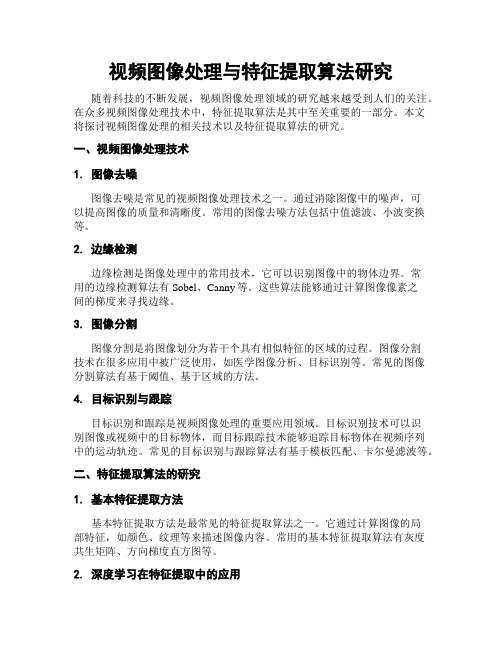
视频图像处理与特征提取算法研究随着科技的不断发展,视频图像处理领域的研究越来越受到人们的关注。
在众多视频图像处理技术中,特征提取算法是其中至关重要的一部分。
本文将探讨视频图像处理的相关技术以及特征提取算法的研究。
一、视频图像处理技术1. 图像去噪图像去噪是常见的视频图像处理技术之一。
通过消除图像中的噪声,可以提高图像的质量和清晰度。
常用的图像去噪方法包括中值滤波、小波变换等。
2. 边缘检测边缘检测是图像处理中的常用技术,它可以识别图像中的物体边界。
常用的边缘检测算法有Sobel、Canny等。
这些算法能够通过计算图像像素之间的梯度来寻找边缘。
3. 图像分割图像分割是将图像划分为若干个具有相似特征的区域的过程。
图像分割技术在很多应用中被广泛使用,如医学图像分析、目标识别等。
常见的图像分割算法有基于阈值、基于区域的方法。
4. 目标识别与跟踪目标识别和跟踪是视频图像处理的重要应用领域。
目标识别技术可以识别图像或视频中的目标物体,而目标跟踪技术能够追踪目标物体在视频序列中的运动轨迹。
常见的目标识别与跟踪算法有基于模板匹配、卡尔曼滤波等。
二、特征提取算法的研究1. 基本特征提取方法基本特征提取方法是最常见的特征提取算法之一。
它通过计算图像的局部特征,如颜色、纹理等来描述图像内容。
常用的基本特征提取算法有灰度共生矩阵、方向梯度直方图等。
2. 深度学习在特征提取中的应用近年来,深度学习技术在图像处理领域取得了巨大的突破。
深度学习算法可以通过构建深层神经网络来学习图像的抽象特征。
常见的深度学习模型有卷积神经网络、循环神经网络等。
3. 基于图像的特征提取基于图像的特征提取方法是一种通过分析图像形状、边缘等特征来描述图像内容的算法。
这种方法可以应用于图像检索、图像分类等领域。
常见的基于图像的特征提取算法有形态学、边缘检测等。
4. 基于时空特征的提取对于视频图像来说,除了静态图像的特征外,还存在时空特征。
基于时空特征的提取算法可以捕捉图像序列中的动态变化信息。
机器视觉中的特征提取与目标识别算法

机器视觉中的特征提取与目标识别算法机器视觉是人工智能领域的一个重要分支,它研究如何使机器具备类似于人类的视觉能力。
在机器视觉应用中,特征提取和目标识别算法起着至关重要的作用。
特征提取是将图像中的信息转化为有意义的特征向量的过程,而目标识别算法则是对提取的特征进行分类和识别的过程。
本文将介绍机器视觉中常用的特征提取和目标识别算法。
一、特征提取算法1. 尺度不变特征变换(Scale-Invariant Feature Transform,SIFT)SIFT算法是一种基于图像局部特征的特征提取算法,它能够在不同尺度、旋转和亮度下提取出鲁棒性较高的特征点。
SIFT算法首先使用高斯滤波器进行尺度空间构建,然后对每个尺度的图像进行关键点检测和描述子生成。
最后,通过特征匹配和筛选来实现目标的识别。
2. 方向梯度直方图(Histogram of Oriented Gradients,HOG)HOG算法是一种基于图像梯度的特征提取算法,它通过计算图像中每个小区域的梯度方向直方图来表示图像的特征。
HOG算法在目标识别领域被广泛应用,特别是人体检测和行人识别。
它能够较好地捕捉目标的形状和边缘信息。
3. 卷积神经网络(Convolutional Neural Network,CNN)CNN是一种深度学习算法,在图像特征提取和目标识别中取得了很大的成功。
CNN通过多个卷积层和池化层来逐步提取图像的特征,并通过全连接层将特征映射到目标的类别。
由于CNN能够通过学习得到更复杂、高级的特征表示,它在许多视觉任务中表现出了很强的性能。
二、目标识别算法1. 支持向量机(Support Vector Machine,SVM)SVM是一种经典的机器学习算法,在目标识别中得到了广泛应用。
SVM通过构建一个现行或非线性的分类超平面来实现目标的二分类或多分类。
对于图像分类任务,可以通过提取好的特征向量作为输入,然后使用SVM来训练分类模型,实现目标的识别。
细粒度图像识别中的特征提取算法研究
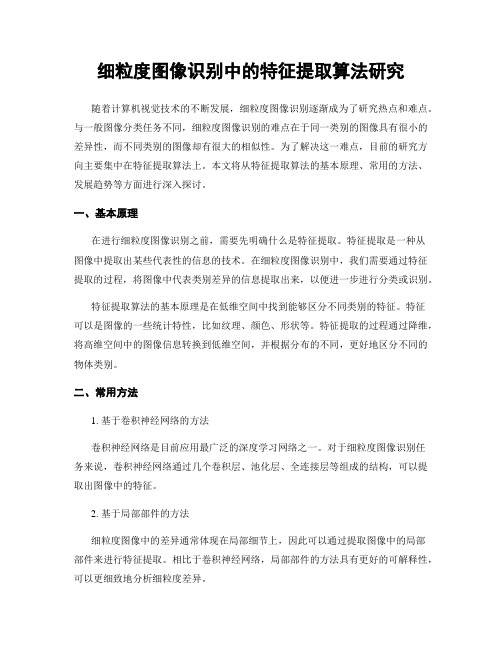
细粒度图像识别中的特征提取算法研究随着计算机视觉技术的不断发展,细粒度图像识别逐渐成为了研究热点和难点。
与一般图像分类任务不同,细粒度图像识别的难点在于同一类别的图像具有很小的差异性,而不同类别的图像却有很大的相似性。
为了解决这一难点,目前的研究方向主要集中在特征提取算法上。
本文将从特征提取算法的基本原理、常用的方法、发展趋势等方面进行深入探讨。
一、基本原理在进行细粒度图像识别之前,需要先明确什么是特征提取。
特征提取是一种从图像中提取出某些代表性的信息的技术。
在细粒度图像识别中,我们需要通过特征提取的过程,将图像中代表类别差异的信息提取出来,以便进一步进行分类或识别。
特征提取算法的基本原理是在低维空间中找到能够区分不同类别的特征。
特征可以是图像的一些统计特性,比如纹理、颜色、形状等。
特征提取的过程通过降维,将高维空间中的图像信息转换到低维空间,并根据分布的不同,更好地区分不同的物体类别。
二、常用方法1. 基于卷积神经网络的方法卷积神经网络是目前应用最广泛的深度学习网络之一。
对于细粒度图像识别任务来说,卷积神经网络通过几个卷积层、池化层、全连接层等组成的结构,可以提取出图像中的特征。
2. 基于局部部件的方法细粒度图像中的差异通常体现在局部细节上,因此可以通过提取图像中的局部部件来进行特征提取。
相比于卷积神经网络,局部部件的方法具有更好的可解释性,可以更细致地分析细粒度差异。
3. 基于对比学习的方法对比学习是一种学习相同和不同样本之间对应关系的方法。
在细粒度图像识别任务中,可以通过对比学习来学习不同类别之间的差异性和相似性,进而实现更好的分类效果。
三、发展趋势1. 多模态融合目前的细粒度图像识别算法大都基于单一的视觉信息进行分析,而在实际应用中,多种模态的信息会对分类结果产生影响。
因此,未来的发展趋势是基于多模态数据的融合,比如图像、文本、声音等各种信息的融合。
2. 自适应特征学习传统的特征提取算法通常是基于手工设计的,对于复杂数据集的应用效果并不好。
- 1、下载文档前请自行甄别文档内容的完整性,平台不提供额外的编辑、内容补充、找答案等附加服务。
- 2、"仅部分预览"的文档,不可在线预览部分如存在完整性等问题,可反馈申请退款(可完整预览的文档不适用该条件!)。
- 3、如文档侵犯您的权益,请联系客服反馈,我们会尽快为您处理(人工客服工作时间:9:00-18:30)。
Histograms offor Human Detection Navneet Dalal and Bill TriggsINRIA Rhˆo ne-Alps,655avenue de l’Europe,Montbonnot38334,France {Navneet.Dalal,Bill.Triggs}@inrialpes.fr,http://lear.inrialpes.frAbstractWe study the question of feature sets for ob-ject recognition,adopting linear SVM based human detec-tion as a test case.After reviewing existing edge and gra-dient based descriptors,we show experimentally that grids of Histograms of Oriented Gradient(HOG)descriptors sig-nificantly outperform existing feature sets for human detec-tion.We study the influence of each stage of the computation on performance,concluding thatfine-scale gradients,fine orientation binning,relatively coarse spatial binning,and high-quality local contrast normalization in overlapping de-scriptor blocks are all important for good results.The new approach gives near-perfect separation on the original MIT pedestrian database,so we introduce a more challenging dataset containing over1800annotated human images with a large range of pose variations and backgrounds.1IntroductionDetecting humans in images is a challenging task owing to their variable appearance and the wide range of poses that they can adopt.Thefirst need is a robust feature set that allows the human form to be discriminated cleanly,even in cluttered backgrounds under difficult illumination.We study the issue of feature sets for human detection,showing that lo-cally normalized Histogram of Oriented Gradient(HOG)de-scriptors provide excellent performance relative to other ex-isting feature sets including wavelets[17,22].The proposed descriptors are reminiscent of edge orientation histograms [4,5],SIFT descriptors[12]and shape contexts[1],but they are computed on a dense grid of uniformly spaced cells and they use overlapping local contrast normalizations for im-proved performance.We make a detailed study of the effects of various implementation choices on detector performance, taking“pedestrian detection”(the detection of mostly visible people in more or less upright poses)as a test case.For sim-plicity and speed,we use linear SVM as a baseline classifier throughout the study.The new detectors give essentially per-fect results on the MIT pedestrian test set[18,17],so we have created a more challenging set containing over1800pedes-trian images with a large range of poses and backgrounds. Ongoing work suggests that our feature set performs equally well for other shape-based object classes.We briefly discuss previous work on human detection in §2,give an overview of our method§3,describe our data sets in§4and give a detailed description and experimentalevaluation of each stage of the process in§5–6.The main conclusions are summarized in§7.2Previous WorkThere is an extensive literature on object detection,but here we mention just a few relevant papers on human detec-tion[18,17,22,16,20].See[6]for a survey.Papageorgiou et al[18]describe a pedestrian detector based on a polynomial SVM using rectified Haar wavelets as input descriptors,with a parts(subwindow)based variant in[17].Depoortere et al give an optimized version of this[2].Gavrila&Philomen [8]take a more direct approach,extracting edge images and matching them to a set of learned exemplars using chamfer distance.This has been used in a practical real-time pedes-trian detection system[7].Viola et al[22]build an efficient moving person detector,using AdaBoost to train a chain of progressively more complex region rejection rules based on Haar-like wavelets and space-time differences.Ronfard et al[19]build an articulated body detector by incorporating SVM based limb classifiers over1st and2nd order Gaussian filters in a dynamic programming framework similar to those of Felzenszwalb&Huttenlocher[3]and Ioffe&Forsyth [9].Mikolajczyk et al[16]use combinations of orientation-position histograms with binary-thresholded gradient magni-tudes to build a parts based method containing detectors for faces,heads,and front and side profiles of upper and lower body parts.In contrast,our detector uses a simpler archi-tecture with a single detection window,but appears to give significantly higher performance on pedestrian images.3Overview of the MethodThis section gives an overview of our feature extraction chain,which is summarized infig.1.Implementation details are postponed until§6.The method is based on evaluating well-normalized local histograms of image gradient orienta-tions in a dense grid.Similar features have seen increasing use over the past decade[4,5,12,15].The basic idea is that local object appearance and shape can often be characterized rather well by the distribution of local intensity gradients or1InputFigure1.An overview of our feature extraction and object detection chain.The detector window is tiled with a grid of overlapping blocks in which Histogram of Oriented Gradient feature vectors are extracted.The combined vectors are fed to a linear SVM for object/non-object classification.The detection window is scanned across the image at all positions and scales,and conventional non-maximum suppression is run on the output pyramid to detect object instances,but this paper concentrates on the feature extraction process.edge directions,even without precise knowledge of the cor-responding gradient or edge positions.In practice this is im-plemented by dividing the image window into small spatial regions(“cells”),for each cell accumulating a local1-D his-togram of gradient directions or edge orientations over the pixels of the cell.The combined histogram entries form the representation.For better invariance to illumination,shad-owing,etc.,it is also useful to contrast-normalize the local responses before using them.This can be done by accumu-lating a measure of local histogram“energy”over somewhat larger spatial regions(“blocks”)and using the results to nor-malize all of the cells in the block.We will refer to the nor-malized descriptor blocks as Histogram of Oriented Gradi-ent(HOG)descriptors.Tiling the detection window with a dense(in fact,overlapping)grid of HOG descriptors and using the combined feature vector in a conventional SVM based window classifier gives our human detection chain (seefig.1).The use of orientation histograms has many precursors [13,4,5],but it only reached maturity when combined with local spatial histogramming and normalization in Lowe’s Scale Invariant Feature Transformation(SIFT)approach to wide baseline image matching[12],in which it provides the underlying image patch descriptor for matching scale-invariant keypoints.SIFT-style approaches perform remark-ably well in this application[12,14].The Shape Context work[1]studied alternative cell and block shapes,albeit ini-tially using only edge pixel counts without the orientation histogramming that makes the representation so effective. The success of these sparse feature based representations has somewhat overshadowed the power and simplicity of HOG’s as dense image descriptors.We hope that our study will help to rectify this.In particular,our informal experiments sug-gest that even the best current keypoint based approaches are likely to have false positive rates at least1–2orders of mag-nitude higher than our dense grid approach for human detec-tion,mainly because none of the keypoint detectors that we are aware of detect human body structures reliably.The HOG/SIFT representation has several advantages.It captures edge or gradient structure that is very characteristic of local shape,and it does so in a local representation with an easily controllable degree of invariance to local geometric and photometric transformations:translations or rotations make little difference if they are much smaller that the local spatial or orientation bin size.For human detection,rather coarse spatial sampling,fine orientation sampling and strong local photometric normalization turns out to be the best strat-egy,presumably because it permits limbs and body segments to change appearance and move from side to side quite a lot provided that they maintain a roughly upright orientation. 4Data Sets and MethodologyDatasets.We tested our detector on two different data sets. Thefirst is the well-established MIT pedestrian database [18],containing509training and200test images of pedestri-ans in city scenes(plus left-right reflections of these).It con-tains only front or back views with a relatively limited range of poses.Our best detectors give essentially perfect results on this data set,so we produced a new and significantly more challenging data set,‘INRIA’,containing180564×128im-ages of humans cropped from a varied set of personal pho-tos.Fig.2shows some samples.The people are usually standing,but appear in any orientation and against a wide variety of background image including crowds.Many are bystanders taken from the image backgrounds,so there is no particular bias on their pose.The database is available from http://lear.inrialpes.fr/data for research purposes. Methodology.We selected1239of the images as positive training examples,together with their left-right reflections (2478images in all).Afixed set of12180patches sampled randomly from1218person-free training photos provided the initial negative set.For each detector and parameter com-bination a preliminary detector is trained and the1218nega-tive training photos are searched exhaustively for false posi-tives(‘hard examples’).The method is then re-trained using this augmented set(initial12180+hard examples)to pro-duce thefinal detector.The set of hard examples is subsam-pled if necessary,so that the descriptors of thefinal training setfit into1.7Gb of RAM for SVM training.This retrain-ing process significantly improves the performance of each detector(by5%at10−4False Positives Per Window tested (FPPW)for our default detector),but additional rounds of retraining make little difference so we do not use them.To quantify detector performance we plot Detection Er-ror Tradeoff(DET)curves on a log-log scale,i.e.miss rate (1−Recall or FalseNegFigure2.Some sample images from our new human detection database.The subjects are always upright,but with some partial occlusions and a wide range of variations in pose,appearance,clothing,illumination and background.probabilities to be distinguished more easily.We will often use miss rate at10−4FPPW as a reference point for results. This is arbitrary but no more so than,e.g.Area Under ROC. In a multiscale detector it corresponds to a raw error rate of about0.8false positives per640×480image tested.(The full detector has an even lower false positive rate owing to non-maximum suppression).Our DET curves are usually quite shallow so even very small improvements in miss rate are equivalent to large gains in FPPW at constant miss rate.For example,for our default detector at1e-4FPPW,every1% absolute(9%relative)reduction in miss rate is equivalent to reducing the FPPW at constant miss rate by a factor of1.57. 5Overview of ResultsBefore presenting our detailed implementation and per-formance analysis,we compare the overall performance of ourfinal HOG detectors with that of some other existing methods.Detectors based on rectangular(R-HOG)or cir-cular log-polar(C-HOG)blocks and linear or kernel SVM are compared with our implementations of the Haar wavelet, PCA-SIFT,and shape context approaches.Briefly,these ap-proaches are as follows:Generalized Haar Wavelets.This is an extended set of ori-ented Haar-like wavelets similar to(but better than)that used in[17].The features are rectified responses from9×9and 12×12oriented1st and2nd derivative boxfilters at45◦inter-vals and the corresponding2nd derivative xyfilter.PCA-SIFT.These descriptors are based on projecting gradi-ent images onto a basis learned from training images using PCA[11].Ke&Sukthankar found that they outperformed SIFT for key point based matching,but this is controversial [14].Our implementation uses16×16blocks with the same derivative scale,overlap,etc.,settings as our HOG descrip-tors.The PCA basis is calculated using positive training im-ages.Shape Contexts.The original Shape Contexts[1]used bi-nary edge-presence voting into log-polar spaced bins,irre-spective of edge orientation.We simulate this using our C-HOG descriptor(see below)with just1orientation bin.16 angular and3radial intervals with inner radius2pixels and outer radius8pixels gave the best results.Both gradient-strength and edge-presence based voting were tested,with the edge threshold chosen automatically to maximize detec-tion performance(the values selected were somewhat vari-able,in the region of20–50graylevels).Results.Fig.3shows the performance of the various detec-tors on the MIT and INRIA data sets.The HOG-based de-tectors greatly outperform the wavelet,PCA-SIFT and Shape Context ones,giving near-perfect separation on the MIT test set and at least an order of magnitude reduction in FPPW on the INRIA one.Our Haar-like wavelets outperform MIT wavelets because we also use2nd order derivatives and con-trast normalize the output vector.Fig.3(a)also shows MIT’s best parts based and monolithic detectors(the points are in-terpolated from[17]),however beware that an exact compar-ison is not possible as we do not know how the database in [17]was divided into training and test parts and the nega-tive images used are not available.The performances of the final rectangular(R-HOG)and circular(C-HOG)detectors are very similar,with C-HOG having the slight edge.Aug-menting R-HOG with primitive bar detectors(oriented2nd derivatives–‘R2-HOG’)doubles the feature dimension but further improves the performance(by2%at10−4FPPW). Replacing the linear SVM with a Gaussian kernel one im-proves performance by about3%at10−4FPPW,at the cost of much higher run ing binary edge voting(EC-HOG)instead of gradient magnitude weighted voting(C-HOG)decreases performance by5%at10−4FPPW,while omitting orientation information decreases it by much more, even if additional spatial or radial bins are added(by33%at 10−4FPPW,for both edges(E-ShapeC)and gradients(G-ShapeC)).PCA-SIFT also performs poorly.One reason is that,in comparison to[11],many more(80of512)principal vectors have to be retained to capture the same proportion of the variance.This may be because the spatial registration is weaker when there is no keypoint detector.6Implementation and Performance Study We now give details of our HOG implementations and systematically study the effects of the various choices on de-DET − different descriptors on MIT databasefalse positives per window (FPPW)m i s s r a t eFigure 3.The performance of selected detectors on (left)MIT and (right)INRIA data sets.See the text for details.tector performance.Throughout this section we refer results to our default detector which has the following properties,described below:RGB colour space with no gamma cor-rection;[−1,0,1]gradient filter with no smoothing;linear gradient voting into 9orientation bins in 0◦–180◦;16×16pixel blocks of four 8×8pixel cells;Gaussian spatial win-dow with σ=8pixel;L2-Hys (Lowe-style clipped L2norm)block normalization;block spacing stride of 8pixels (hence 4-fold coverage of each cell);64×128detection window;linear SVM classifier.Fig.4summarizes the effects of the various HOG param-eters on overall detection performance.These will be exam-ined in detail below.The main conclusions are that for good performance,one should use fine scale derivatives (essen-tially no smoothing),many orientation bins,and moderately sized,strongly normalized,overlapping descriptor blocks.6.1Gamma/Colour NormalizationWe evaluated several input pixel representations includ-ing grayscale,RGB and LAB colour spaces optionally with power law (gamma)equalization.These normalizations have only a modest effect on performance,perhaps because the subsequent descriptor normalization achieves similar results.We do use colour information when available.RGB and LAB colour spaces give comparable results,but restricting to grayscale reduces performance by 1.5%at 10−4FPPW.Square root gamma compression of each colour channel im-proves performance at low FPPW (by 1%at 10−4FPPW)but log compression is too strong and worsens it by 2%at 10−4FPPW.6.2Gradient ComputationDetector performance is sensitive to the way in which gradients are computed,but the simplest scheme turns out to be the best.We tested gradients computed using Gaus-sian smoothing followed by one of several discrete deriva-tive masks.Several smoothing scales were tested includ-ing σ=0(none).Masks tested included various 1-D point derivatives (uncentred [−1,1],centred [−1,0,1]and cubic-corrected [1,−8,0,8,−1])as well as 3×3Sobel masks and 2×2diagonal ones 01−10 , −1001 (the most compact cen-tred 2-D derivative masks).Simple 1-D [−1,0,1]masks at σ=0work ing larger masks always seems to de-crease performance,and smoothing damages it significantly:for Gaussian derivatives,moving from σ=0to σ=2reduces the recall rate from 89%to 80%at 10−4FPPW.At σ=0,cubic corrected 1-D width 5filters are about 1%worse than [−1,0,1]at 10−4FPPW,while the 2×2diagonal masks are 1.5%ing uncentred [−1,1]derivative masks also decreases performance (by 1.5%at 10−4FPPW),presum-ably because orientation estimation suffers as a result of the x and y filters being based at different centres.For colour images,we calculate separate gradients for each colour channel,and take the one with the largest norm as the pixel’s gradient vector.6.3Spatial /Orientation BinningThe next step is the fundamental nonlinearity of the de-scriptor.Each pixel calculates a weighted vote for an edge orientation histogram channel based on the orientation of the gradient element centred on it,and the votes are accumu-lated into orientation bins over local spatial regions that we call cells .Cells can be either rectangular or radial (log-polar sectors).The orientation bins are evenly spaced over 0◦–180◦(“unsigned”gradient)or 0◦–360◦(“signed”gradient).To reduce aliasing,votes are interpolated bilinearly between the neighbouring bin centres in both orientation and posi-tion.The vote is a function of the gradient magnitude at the pixel,either the magnitude itself,its square,its square root,or a clipped form of the magnitude representing soft pres-ence/absence of an edge at the pixel.In practice,using them i s s r a t eFigure 4.For details see the text.(a)Using fine derivative scale significantly increases the performance.(‘c-cor’is the 1D cubic-corrected point derivative).(b)Increasing the number of orientation bins increases performance significantly up to about 9bins spaced over 0◦–180◦.(c)The effect of different block normalization schemes (see §6.4).(d)Using overlapping descriptor blocks decreases the miss rate by around 5%.(e)Reducing the 16pixel margin around the 64×128detection window decreases the performance by about 3%.(f)Using a Gaussian kernel SVM,exp(−γ x 1−x 2 2),improves the performance by about 3%.magnitude itself gives the best results.Taking the square root reduces performance slightly,while using binary edge pres-ence voting decreases it significantly (by 5%at 10−4FPPW).Fine orientation coding turns out to be essential for good performance,whereas (see below)spatial binning can be rather coarse.As fig.4(b)shows,increasing the number of orientation bins improves performance significantly up to about 9bins,but makes little difference beyond this.This is for bins spaced over 0◦–180◦,i.e .the ‘sign’of the gradi-ent is ignored.Including signed gradients (orientation range 0◦–360◦,as in the original SIFT descriptor)decreases the performance,even when the number of bins is also doubled to preserve the original orientation resolution.For humans,the wide range of clothing and background colours presum-ably makes the signs of contrasts uninformative.However note that including sign information does help substantially in some other object recognition tasks,e.g .cars,motorbikes.6.4Normalization and Descriptor BlocksGradient strengths vary over a wide range owing to local variations in illumination and foreground-background con-trast,so effective local contrast normalization turns out to be essential for good performance.We evaluated a num-M i s s R a t e (%)Figure 5.The miss rate at 10−4FPPW as the cell and block sizes change.The stride (block overlap)is fixed at half of the block size.3×3blocks of 6×6pixel cells perform best,with 10.4%miss rate.ber of different normalization schemes.Most of them are based on grouping cells into larger spatial blocks and con-trast normalizing each block separately.The final descriptor is then the vector of all components of the normalized cell responses from all of the blocks in the detection window.In fact,we typically overlap the blocks so that each scalarcell response contributes several components to thefinal de-scriptor vector,each normalized with respect to a differentblock.This may seem redundant but good normalization iscritical and including overlap significantly improves the per-formance.Fig.4(d)shows that performance increases by4%at10−4FPPW as we increase the overlap from none(stride16)to16-fold area/4-fold linear coverage(stride4).We evaluated two classes of block geometries,square orrectangular ones partitioned into grids of square or rectangu-lar spatial cells,and circular blocks partitioned into cells inlog-polar fashion.We will refer to these two arrangementsas R-HOG and C-HOG(for rectangular and circular HOG).R-HOG.R-HOG blocks have many similarities to SIFT de-scriptors[12]but they are used quite differently.They arecomputed in dense grids at a single scale without dominantorientation alignment and used as part of a larger code vectorthat implicitly encodes spatial position relative to the detec-tion window,whereas SIFT’s are computed at a sparse setof scale-invariant key points,rotated to align their dominantorientations,and used individually.SIFT’s are optimized forsparse wide baseline matching,R-HOG’s for dense robustcoding of spatial form.Other precursors include the edgeorientation histograms of Freeman&Roth[4].We usuallyuse square R-HOG’s,i.e.ς×ςgrids ofη×ηpixel cells eachcontainingβorientation bins,whereς,η,βare parameters.Fig.5plots the miss rate at10−4FPPW w.r.t.cell size andblock size in cells.For human detection,3×3cell blocksof6×6pixel cells perform best,with10.4%miss-rate at10−4FPPW.In fact,6–8pixel wide cells do best irrespec-tive of the block size–an interesting coincidence as humanlimbs are about6–8pixels across in our images.2×2and3×3blocks work best.Beyond this,the results deteriorate:adaptivity to local imaging conditions is weakened when theblock becomes too big,and when it is too small(1×1block/normalization over orientations alone)valuable spatial in-formation is suppressed.As in[12],it is useful to downweight pixels near the edgesof the block by applying a Gaussian spatial window to eachpixel before accumulating orientation votes into cells.Thisimproves performance by1%at10−4FPPW for a Gaussianwithσ=0.5∗blockv 22+ 2;(b)L2-Hys,L2-norm followed by clipping(limiting the maxi-mum values of v to0.2)and renormalizing,as in[12];(c)L1-norm,v→v/( v 1+ );and(d)L1-sqrt,L1-norm fol-lowed by square root v→ate descriptors densely,including on empty patches,but the results are insensitive to ’s value over a large range. Centre-surround normalization.We also investigated an alternative centre-surround style cell normalization scheme, in which the image is tiled with a grid of cells and for each cell the total energy in the cell and its surrounding re-gion(summed over orientations and pooled using Gaussian weighting)is used to normalize the cell.However asfig.4(c) (“window norm”)shows,this decreases performance relative to the corresponding block based scheme(by2%at10−4 FPPW,for pooling withσ=1cell widths).One reason is that there are no longer any overlapping blocks so each cell is coded only once in thefinal descriptor.Including several normalizations for each cell based on different pooling scales σprovides no perceptible change in performance,so it seems that it is the existence of several pooling regions with differ-ent spatial offsets relative to the cell that is important here, not the pooling scale.To clarify this point,consider the R-HOG detector with overlapping blocks.The coefficients of the trained linear SVM give a measure of how much weight each cell of each block can have in thefinal discrimination decision.Close ex-amination offig.6(b,f)shows that the most important cells are the ones that typically contain major human contours(es-pecially the head and shoulders and the feet),normalized w.r.t.blocks lying outside the contour.In other words—despite the complex,cluttered backgrounds that are com-mon in our training set—the detector cues mainly on the contrast of silhouette contours against the background,not on internal edges or on silhouette contours against the fore-ground.Patterned clothing and pose variations may make internal regions unreliable as cues,or foreground-to-contour transitions may be confused by smooth shading and shad-owing effects.Similarly,fig.6(c,g)illustrate that gradients inside the person(especially vertical ones)typically count as negative cues,presumably because this suppresses false pos-itives in which long vertical lines trigger vertical head and leg cells.6.5Detector Window and ContextOur64×128detection window includes about16pixels of margin around the person on all four sides.Fig.4(e) shows that this border provides a significant amount of con-text that helps detection.Decreasing it from16to8pixels (48×112detection window)decreases performance by6% at10−4FPPW.Keeping a64×128window but increasing the person size within it(again decreasing the border)causes a similar loss of performance,even though the resolution of the person is actually increased.6.6ClassifierBy default we use a soft(C=0.01)linear SVM trained with SVMLight[10](slightly modified to reduce memory usage for problems with large dense descriptor vectors).Us-ing a Gaussian kernel SVM increases performance by about 3%at10−4FPPW at the cost of a much higher run time. 6.7DiscussionOverall,there are several notablefindings in this work. The fact that HOG greatly out-performs wavelets and that any significant degree of smoothing before calculating gra-dients damages the HOG results emphasizes that much of the available image information is from abrupt edges atfine scales,and that blurring this in the hope of reducing the sen-sitivity to spatial position is a mistake.Instead,gradients should be calculated at thefinest available scale in the current pyramid layer,rectified or used for orientation voting,and only then blurred spatially.Given this,relatively coarse spa-tial quantization suffices(8×8pixel cells/one limb width). On the other hand,at least for human detection,it pays to sample orientation ratherfinely:both wavelets and shape contexts lose out significantly here.Secondly,strong local contrast normalization is essen-tial for good results,and traditional centre-surround style schemes are not the best choice.Better results can be achieved by normalizing each element(edge,cell)several times with respect to different local supports,and treating the results as independent signals.In our standard detector, each HOG cell appears four times with different normaliza-tions and including this‘redundant’information improves performance from84%to89%at10−4FPPW.7Summary and ConclusionsWe have shown that using locally normalized histogram of gradient orientations features similar to SIFT descriptors [12]in a dense overlapping grid gives very good results for person detection,reducing false positive rates by more than an order of magnitude relative to the best Haar wavelet based detector from[17].We studied the influence of various de-scriptor parameters and concluded thatfine-scale gradients,fine orientation binning,relatively coarse spatial binning, and high-quality local contrast normalization in overlapping descriptor blocks are all important for good performance. We also introduced a new and more challenging pedestrian database,which is publicly available.Future work:Although our current linear SVM detector is reasonably efficient–processing a320×240scale-space im-age(4000detection windows)in less than a second–there is still room for optimization and to further speed up detections it would be useful to develop a coarse-to-fine or rejection-chain style detector based on HOG descriptors.We are also working on HOG-based detectors that incorporate motion in-formation using block matching or opticalflowfields.Fi-nally,although the currentfixed-template-style detector has proven difficult to beat for fully visible pedestrians,humans are highly articulated and we believe that including a parts based model with a greater degree of local spatial invariance。
